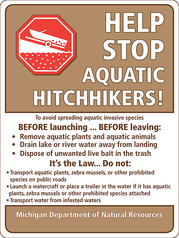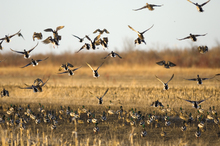|
|
|
Newsletter - Fall 2015
|
 Welcome to the first Michigan Waterfowl Legacy E-Newsletter; our first non-PDF publication! We hope you enjoy the new, easier to access format.
For new members, you are joining hundreds of people who are also
passionate about Michigan’s waterfowl and wetlands. We appreciate your
continued support! Members can expect our newsletters quarterly throughout the
year.
Staring January 2016,
Michigan Waterfowl Legacy will be starting its first newsletter for kids! If
you know a kid who loves the outdoors or is interested in wildlife, then make
sure to get them signed up to receive their own newsletter! Just visit www.surveymonkey.com/r/LCLRTB9
to sign them up!
|
 The Michigan Waterfowl Legacy is ready to take
action, to help preserve and protect wetland habitats. We need your help! The first step you can take is to help clean
up wetlands. By picking up a piece of litter on a walk, you can make a big
difference. If you visit a wetland, make sure you pick up any trash you have,
including spent shotgun shells. When out enjoying the many wonders of the
wetlands, do not disturb or damage local vegetation. Joining a local wetland or waterfowl
conservation group is another great way to get involved. Conservation groups
may set up local projects that help clean up and restore wetlands. Remember, leave
the wetland in better shape than what you found it in.
After visiting a
wetland, make sure to wash off aquatic vegetation, animals, and mud from
footwear, equipment, boats, and trailers before going to another area. Live
wells, bilges, and any other vessels containing water from the area needs to be
dumped out prior to departure. These practices will help stop the spread of
invasive species that can harm wetlands and other habitats.
To learn more about
preventing the spread of aquatic invasive species in Michigan, please visit: www.michigan.gov/deq, What Can YOU Do?, or
Cleaning
Boats and Equipment to Prevent AIS.
|
|
 Michigan’s wetlands have ample water and natural
food, making them vital stopping spots for migrating birds. An average snow
pack and good rainfall throughout the spring and summer has filled wetland
basins and conditions look favorable entering the fall.
The duck breeding
populations in Michigan were estimated at 431,000, which have increased from
the 2014 estimate of 395,000. The total duck breeding population is below the
long-term 1991-2014 average by 33%. The mallard breeding population has been
estimated to be around 238,000 for 2015. This is a 3% increase from the 2014
season.
The Mississippi Valley Canada
goose population had low breeding pair numbers and average nesting efforts this
year. The breeding adults were estimated to be around 226,500 in 2015. This is
a 30% decrease from the 2014 season. This suggests that
Michigan will see an average to below average fall flight for the migration.
However, the resident Canada goose populations, which account for more than 70
percent of the state's total harvest, are above population goals, so hunters
should have a favorable season.
|
|
 Yes, the elusive snipe does exist and you do not
need a pillow case and a flashlight to find them. The snipe is part of the sandpiper family and
is a medium to long distance migrant. Snipe breed in Michigan in the summer and
can be seen migrating through in the fall. The global breeding population of
snipe, shared between the U.S. and Canada, is estimated to be around two
million birds. The snipe is a stocky shorebird with a very long straight bill.
The eyes of a snipe are set far back on the head, giving them an almost full
range of vison. This incredible sense of sight makes it extremely difficult for
potential predators, including humans, to sneak up on. Snipe often know you are
present before you ever see them. They often sit tight in one location until a
person is almost on top of them. A snipe will suddenly flush from its hiding
spot and use a zigzagging flight pattern to evade the threat. The flight of a
snipe is very distinct because the tail feathers make a “winnowing” sound when
air moves over them in a certain way. When the snipe is in flight, they can
reach speeds up to 60 miles per hour.
Common snipe have a cryptic coloration pattern
of brown, buff, and white. This pattern has been developed to help conceal the
birds in varying habitats. Snipe can be
found along muddy pond edges and damp fields. Snipe forage on the muddy ground
by probing with their long bills for earthworms and other invertebrates. Snipe
prefer low growing vegetation with patches of thick cover. Fence posts are
another preferred area for snipe to perch during the summer months. If you are
hoping to see these elusive birds, look in open wetland areas during the spring
and summer. Snipe are most active around dawn and dusk.
The abundant snipe
population in Michigan has allowed for a hunting season to be set. The U.S.
Fish and Wildlife Service estimates hunters around the country harvest about
136,000 snipe each year. The 2015 Michigan season starts September 1st
and runs to November 9th. The
daily bag limit for snipe is 8 birds, and a possession limit of 24 altogether. Before
hunting snipe, a hunter must purchase all necessary hunting licenses and participate
in the Migratory Bird Harvest Information Program (HIP). A hunter must have proof of participation
with them whenever they are hunting migratory birds, such as snipe. Learn more
about necessary hunting licenses in the 2015 Waterfowl digest or by visiting Michigan
DNR Digests.
|
 Michigan is host to the seven magnificent wetland wonders, known as Managed Waterfowl Hunt Areas (MWHA). The seven MWHA include the Allegan State Game Area’s Fennville Farm Unit, Fish Point, Harsens Island, Muskegon County Wastewater Facility/ Muskegon State Game Area, Nayanquing Point, Pointe Mouillee State Game Area, and the Shiawassee River State Game Area.
The Wetland Wonders Challenge is a unique contest for waterfowl hunters who utilize Michigan’s Wetland Wonders. The Wetland Wonders Challenge starts October 10th 2015 and runs through January 31st 2016. Hunters can enter the challenge by visiting three of the official site and filling out an entry form. If a hunter visits four or more sites, then they will receive a bonus entry into the contest for each site visited. Participants who submit a punch card with punches from all seven sites will receive a prize. The punch cards will only be validated during regular MWHA check station hours and on days when managed drawings for hunt zones are conducted. Hunting the sites outside these guidelines will result in not getting a punch from that site. Completed punch cards can be submitted at any MWHA. The Michigan United Conservation Clubs (MUCC) will draw seven winners on February 15th 2016 for the ultimate prize packages. The ultimate prize package is valued at approximately $1,500. The prizes include:
- A shotgun provided by Ducks Unlimited
- Zink custom Duck Call and Zink custom Goose Call
- Avian X Goose Decoys and Avian X Mallard Duck Decoys
- A Golden Ticket, which is good for one first choice at a Managed Waterfowl Hunt Area hunt (non-reserved) for the 2016-17 waterfowl hunting season
- A set of all 7 collectible Wetland Wonder Challenge 2015-16 bands
- Waterfowl Hunting gear including a shotgun case, decoy anchors, waterfowl field bag, game strap, hunting cushion, and more)
You can find more details about the Wetland Wonders Challenge by visiting: www.michigan.gov/wetlandwonders
|
- North
Zone
- Ducks, Mergansers, and Coot Sept. 26-
Nov. 22 and Nov. 28-29
-
Geese Sept. 11- Dec. 11
- Middle
Zone
- Ducks, Mergansers, and Coot Oct. 3- Nov.
29 and Dec. 12-13
-
Geese Sept. 19- Dec. 19
- South
Zone
- Ducks, Mergansers, and Coot Oct. 10- Dec
6 and Dec 26-27
-
Goose season ranges from Sept. 19- Feb.
15 2016, depending on location and species. For more details, visit www.mi.gov/dnrdigests
for specifics on Waterfowl
Hunting
- Statewide
-
Snipe, Virginia Rail, Sora Rail, and
Moorhens Sept. 1- Nov. 9
Thank you for your support of the Michigan Waterfowl
Legacy.
Like us on Facebook
at www.facebook.com/michiganwaterfowllegacy
|
|
|
|